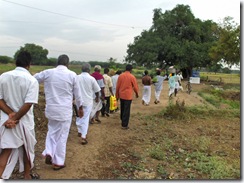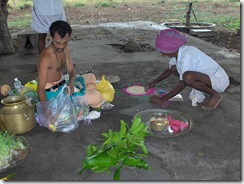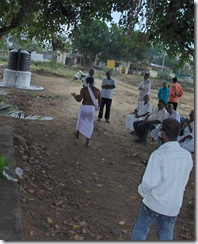Indian Village 13-day ceremony: By Richard Clarke
The ceremony – Shraddha
After a death in India, the body is cremated or buried usually within one day of the death. Then a few days later an elaborate ceremony is performed, called shraddha. The details of this vary by location and caste. In Tamil Nadu the number of days after the death that this is done depends on the age of the person. The idea is that the atma (soul) takes longer to free itself from the home and family the longer the person lives. During the time between the death and this ceremony, the household where the person died is considered unclean. The residents cannot cook food, etc. In part these ceremonies are seen as contributing to the merit of the deceased, but they also pacify the soul so that it will not linger in this world as a ghost but will pass through the realm of Yama, the god of death.
The ceremony marks the time when the atma is released to what comes next.
This posting shows the 13 day ceremony for a village woman who was 55 years old, widowed, with two sons and a daughter. The funeral was shown in an earlier posting.
The mother’s house – the location
In the village street, a canopy is set up in front of Mother’s house (to the right). Another village house is shown in the picture on the right.


Village women are gathered to cook. These will not be residents of the household of the dead mother, since these are considered as still ‘unclean,’ so cannot be involved with food preparation.
Views from the village
Here is Arunachala from the village
Surrounding the village are fields where rice, coconuts and ‘groundnuts’ (peanuts) are grown, and cows and goats forage.
Puja in Mother’s house
First a puja is offered for Mother inside her house. The Brahmin priest builds an altar, starting with a banana leaf, then a bed of uncooked rice. He prepares a pot by winding string around it, then placing water in it. Leave are put in the pot, then a coconut. The coconut is decorated with flowers. The first son, “Anna,” and another male relative start the puja. They will offer flowers by tossing them to the altar, and then Anna offers camphor to the altar, then to his mother.
When this is concluded the priest will take the water in the pot, which has now been consecrated by the puja and so is holy water, and ‘bless’ the people with the water.
Procession to village temple
This ceremony requires different music than the drumming of the first day. A horn and drum create different sounds and rhythms than previously. The the musicians start playing and the village men, with male relatives of Mother, go in procession to the village temple, carrying the puja items that will be used there. Anna carries young plants that will be planted at the site of Mother’s ashes.
This is a small village with no walled temple. Rather there is an outside shrine, not shown here, with the tree and platform next two it. These ceremonies are usually preformed under a tree, in a special place in Hindu temples.
This simple temple and tree-temple are hundreds of years old.
Preparing for the Tree-Temple puja
Now preparations for the puja begins. Anna is shaved of all facial hair. He has not shaved since the death of his mother. The priest and a villager work together to lay out the puja items. The specific items used depend first on whether it was a man or a woman, and if a woman, depending on whether her husband survives her, or she is a widow. This is a puja is for a widow.
Preparation of puja altar with shrines for two gods
The priest builds the puja alter. As before, it starts with banana leaves and a bed of rice. Water again is put into pots, then leaves and a coconut. The ‘gods’ symbolized by coconuts are also decorated with flowers.
Preparing eldest son for puja
Now since these were not to top two castes (who do not wear the Sacred Thread) then the priest makes one for Anna and puts it over his right shoulder.
There are different methods of wearing the Sacred Thread at different occasions. While performing an auspicious ceremony one should be Upaviti, that is, the Sacred Thread should hang from one’s left shoulder. At the performance of some inauspicious ceremony one should be Prachnaviti, that is, the Sacred Thread should hang from the right shoulder; and at times it is called Niviti when the Sacred Thread is worn around the neck like a garland.
The Puja
Now Anna performs the puja, again offering flowers and camphor. The the ‘gods’ are dressed up in dhotis.
Preparing the coconut frond

While the puja is going on, a man takes a half of a coconut frond and starts weaving it together to make the triangular structure that will later be used to offer favorites foods to Mother.
Ashes and Booma, Earth Mother
Then a small symbolic white cloth, set into a wooden frame, is placed on a bed of dry plant material on the ground, and burnt. This invokes Booma, Earth Mother. These ashes resulting from this burning are mixed with other holy materials, and carried by Anna to a nearby tank.
Anna then enters the tank and disperses the ashes into the water. He then submerges himself fully into the water to wash away the impurity that has been his since he lit his mother’s cremation pyre. The second son stands by.
Rice Balls – Pindas
The sons returned to the priest. Balls of rice and Mother’s favorite foods have been prepared. One ball represents mother. It is broken, and merged it into the ancestors. This process, known as Sapindikarana marks the end of mother’s journey. After this, the anna makes a pranam and turns in a circle (honoring the world). Both sons are led into the nearby field by a village elder, who yells “kaa kaa,” to call the crows. The rice is left in the field for the crows.
The village women join the ceremony
After the sons went into the field with the rice for the crows, the village women joined the men at the tree temple. A different ‘altar’ was set up with small inverted ceramic pots holding up a bowl. There were two pots, containing honey and milk, with sticks in them. Some men and women would dip sticks into the pots and then offer these into the bowl. When this was finished, the sons and the priest came over to the bowl for further puja. The sons sat, and the priest placed their outreached hands, with the younger son’s hand above the elder son’s, which was in turn above the bowl. The priest then poured various things, such as water, milk, turmeric, and kum kum, through their hands into the bowl.
Ceremonial meal for the deceased mother
Then it seemed like a ceremonial meal was offered to the mother. While the puja was going on, a man was weaving a coconut fronds. He formed these into a triangular structure, and put it on the ground in front of the tree-temple. Puja items were put into it, and about six banana leaf plates loaded with food were put in front of this. The sons offered camphor to it, and then they (and a few others) walked pradakshina, circling this structure three times.
Rice flour balls
Then the priest formed a roll of flour dough and cut it into six pieces. He put dabs of turmeric and kum kum on top of 3 balls, and the sons combined each of these with the other three, forming three larger balls. Then there was the final trip to the water tank. This time both sons, as well as the daughter and another woman, got into the tank and immersed themselves, and the dough balls were offered and dissolved in the water. The ‘celebrants’ climbed out the steep rock walls of the tank, and then returned to the area under the tree temple.
Gifts for the family
The last act was gift giving by the relatives and villagers. This is needed since the children are not, per custom, allowed to buy any new clothes for themselves for the next year, the period of mourning. Nor will they celebrate the normal festivals, etc. during this period. People offered gifts of clothing and money to the sons and daughter. They gave them to the priest, stating their names, and the priest in turn blessed them by dabbing them with kum kum and then giving them to the sons and daughter. While the sons and the daughter were taking off their old clothes on putting on the new, gifts were being offered in turn to other family members.
Everyone is given a special meal
After this, everyone walked back to the village and sat under the canopy and ate the meal that had been prepared all morning by the village women. It was a pretty typical South India lunch, served on a banana leaf. Rice and sambar, fritters, rasam and buttermilk, with a small serving of sour lemon pickle. Since this was a special occasion several side dishes were also given, none of which I could identify.
The men were seated and fed first. Since my wife is a westerner she was allowed to eat with me and the men. After the men finished eating, the tables were cleared of the banana leaves and the women were able to sit and eat.










































